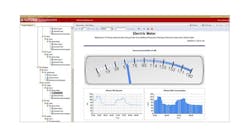Energy-efficiency initiatives in industrial environments used to be synonymous with regulatory-compliance efforts or sustainability campaigns. But more manufacturers are adopting energy-efficiency programs as part of their overall business strategy for increasing profitability.
In April, the U.S. Energy Information Administration reported that total energy consumption in the manufacturing sector decreased by 17 percent from 2002 to 2010 while gross output decreased by only 3 percent. This indicates energy efficiency is increasing. Manufacturers realize that volatile energy prices and scarce resources can have a major impact on their overall competitiveness. For instance, insufficient power reserves in Texas could lead to rotating outages this summer, the North American Electric Reliability Corp. reported in its “2013 Summer Reliability Assessment.”
Manufacturers that have achieved the most success cutting their power use have adopted intelligent technologies that can mine and analyze critical energy data. “Energy-intelligence tools can help manufacturers cut their energy use by 3 to 7 percent,” says Phil Kaufman, business manager, industrial energy development, Rockwell Automation. Energy intelligence puts energy data into context so manufacturers can make more informed decisions about power management. Without energy-intelligence tools, manufacturers may have volumes of consumption data, but they lack insight into what’s causing energy losses.
“For example, if you buy an energy-awareness software package, you’ll see a bunch of power meters and flow meters without any context on what that energy is,” Kaufman says. “It’s just an amount of energy.”
Optimizing WAGES
Rockwell Automation addresses energy-analysis challenges with its FactoryTalk® VantagePoint energy package. The bundle includes FactoryTalk VantagePoint EMI software and energy-specific models, charts, trends, dashboards and analysis tools that provide access to more energy data. The company also offers FactoryTalk EnergyMetrix™ software for access to critical energy information, as well as Allen-Bradley® IntelliCENTER® energy software for a pre-configured energy approach for intelligent motor control devices in the motor control center. These packages leverage one another for the right-fit solution.
Together, these tools help plant and operations managers collect, record and store energy data and then view resource consumption in relation to specific units, lines and machines. Energy intelligence can provide in-depth analysis of water, air, gas, electricity and steam data, also known as WAGES.
“Manufacturers understand that before they can make improvements in their facilities and operations, they need to know how they’re using energy,” says Mary Burgoon, market development manager for sustainable production, power generation and energy management at Rockwell Automation.
Small-engine manufacturer Briggs & Stratton deployed FactoryTalk EnergyMetrix software in 2011 along with 12 Allen-Bradley PowerFlex® 700 variable frequency drives as part of an effort to regenerate power at its reliability testing lab in Milwaukee. The EnergyMetrix application records and stores energy data from Allen-Bradley or third-party power meters. The software also captures information on energy usage, flow, temperature and pressure from controllers, third-party devices or manual entries.
Managers at Briggs & Stratton’s reliability lab needed a system with customized visualization and historical tracking capabilities to track and measure top-priority power issues. They access information from EnergyMetrix software via Allen-Bradley PowerMonitors™ meters installed throughout the Milwaukee campus. They then create reports about energy-use trends to share with the various departments in the plant.
PowerMonitor meters are similar to residential utility meters. Users typically place them inside the plant on main lines and switchgears. Some customers even use PowerMonitor meters to check the accuracy of their utility meters. “We have customers who have been able to go back and collect hundreds of thousands of dollars in overpaid energy bills,” Kaufman says.
The information Briggs & Stratton gained from the system helped the lab generate as much as 556,000 kilowatt-hours of electricity annually. That captured electricity is fed back to the plant’s internal grid. The company expects to save approximately $50,000 per year with its regeneration project.
Empowering Machine Operators
Energy intelligence can also help plant operators make more informed decisions about how their actions impact energy consumption. Many machines already have metering capabilities that provide performance data. Energy-intelligence tools are capable of extracting that data and translating it into analytical power information.
“We’re allowing the operator to make some decisions around how he’s using his machine, what he’s producing and the settings of that equipment,” says Jan Pingle, product manager, information software, Rockwell Automation. “Energy intelligence is driving that energy information down to the asset level of the actual production information. If you can correlate energy and production information together, you get more granular information for better decision making.”
By tying this data together an operator can see whether a maintenance issue is causing an energy loss. Energy intelligence allows the operators to view trends and key performance indicators in real time to help them make maintenance decisions that impact energy use. An operator can input operating limits into the monitoring system. If the machine runs outside those limits, the operator can take appropriate action, Pingle says.
The data enables companies to change behaviors, which ultimately increase profitability. The adoption of energy-intelligence tools has proliferated beyond energy-intensive process industries. More discrete manufacturers, such as packaging for food and beverage and auto makers, are installing energy-intelligence packages as well. “People are seeing the savings, and I think it’s finally sinking in that this was needed all along, across many industries,” Kaufman says.
Allen-Bradley, EnergyMetrix, FactoryTalk, IntelliCENTER, PowerFlex and PowerMonitors are trademarks of Rockwell Automation Inc.
-------------------------------------------------------------------------------------
Related Content
Read the Energy Intelligence E-Book
Energy Management Today Makes for a Brighter Tomorrow (Sustainability)
More information on Energy Intelligence
RSTechED Session PE08 - Energy Monitoring and Control with Rockwell Automation Energy Intelligence Portfolio - PowerPoint
RSTechED Session APP05 - Barry Callebaut: Production and Energy Reporting - PowerPoint



